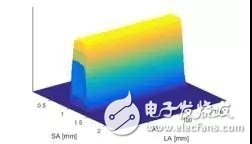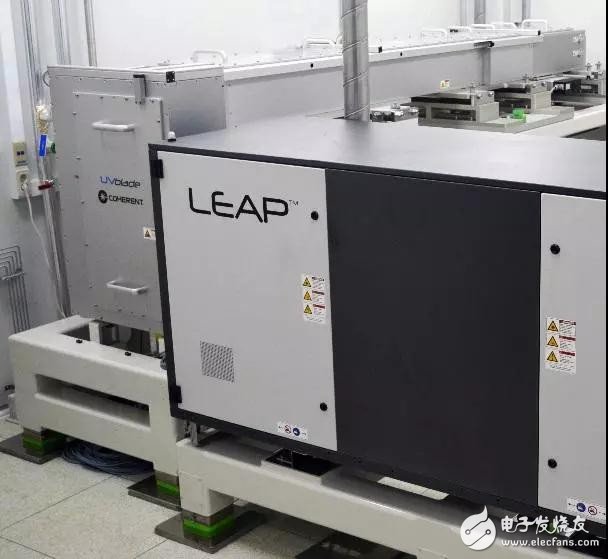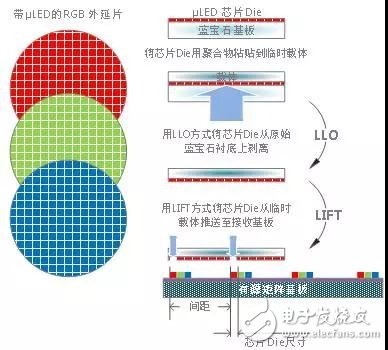Micro-LEDs (μLEDs) for inorganic III-V semiconductors (such as GaN) can be used to produce displays with much higher electrical efficiency, brightness, pixel density, lifetime and application range than the prior art. However, to achieve the transition from current LED devices (approximately 200 μm) to μLEDs (approximately 20 μm), there must be support for technological innovation, especially in the assembly of μLED displays. This article describes how to solve two of the toughest problems in this process with excimer lasers.
Laser Stripping Technology (LLO)Due to the relatively low lattice mismatch and cost of sapphire chips, most current LED manufacturing processes use sapphire chips as substrates for MOCVD crystal growth. However, sapphire is not an ideal carrier material for finished GaN LEDs because of its poor thermal and electrical conductivity, which limits the extractable flux. As a result, in the process of producing high-brightness GaN LEDs, a final step is required to bond the device to the final or temporary carrier and then separate the device from the "sacrificial layer" sapphire substrate. For the μLED, in order to manufacture a small-sized thin device that constitutes a flexible display, it is apparent that the sapphire substrate must be removed.

figure 1. Schematic diagram of removing the sapphire substrate by laser lift-off technique a) device crystal growth and adhesion to the carrier substrate b) laser beam penetrating the sapphire substrate c) removing the sapphire substrate
Laser lift-off using an excimer laser is the most common method of removing sapphire substrates. During processing, high-intensity laser pulses penetrate the sapphire substrate (the excimer laser beam with a wavelength of 248 nm can penetrate) and directly illuminate the LED chip. At the same time, the GaN layer absorbs a large amount of ultraviolet light and has a very thin layer decomposed into gallium and nitrogen. The resulting air pressure pushes the device away from the substrate, enabling separation of the device from the substrate with little or no force on the device. Gallium can be washed away with water or dilute hydrochloric acid to keep the surface of the device clean.
In addition to wavelength, another important feature of excimer lasers is the short pulse (about 10-20 ns), which helps to suppress thermal diffusion and minimize the thermal load on the device. In addition, the laser output from the excimer laser can form an elongated beam (flat-top beam) whose energy is evenly distributed along the two axes. (Fig. 2) For example, the energy uniformity of a 155 mm x to 0.5 mm beam provided by a coherent company's UVblade system is better than 2% standard deviation (sigma). In this way, all processing areas will receive the same and optimal energy flux, thus avoiding the problem of energy overshoot or excessive thermal load during processing. This problem is in other laser processing where the energy intensity is Gaussian. It often appears.

figure 2. UVblade (248 nm) 155 mm laser beam profile with short axis (SA) and long axis (LA).
Note that the difference between the two axis scales is two orders of magnitude.
The excimer LLO is essentially a single pulse process and therefore requires a high level of laser beam uniformity and stability. Laser manufacturer coherent companies have developed products that meet this need, offering superior pulse stability (eg, < 1% rms), greatly improving process control during processing and helping users increase process intervals.

image 3. UVblade LLO system with LEAP excimer laser and beam optics.
During the operation, the excimer laser beam sweeps the substrate and separates the device by illuminating the entire processing area. If high-yield is to be achieved, the harness will be adjusted to cover the sapphire chip (2", 4" or 6") in a single scan. This method requires a medium-intensity laser (eg 50 to 100 W). Effective thermal expansion The coefficient of the mismatch causes a uniform release of the film's internal stress, further reducing the impact on the device. Therefore, this 248 nm method is the most common method for implementing LLO.
Another LLO strategy is to scan the entire chip with a smaller beam and grating. For example, a coherent company has a UVblade system that produces a beam that is 26 mm long and 0.5 mm wide and can cover 2" chips with only two scans. This typical system requires only a laser with a power of 30 W and a wavelength of 248 nm. The scanning method requires a controlled overlap of single shots in the scan direction, as well as overlap between scans.
Laser induced forward transfer (LIFT)Assembling high-resolution displays containing millions of μLED chips faces unique challenges. In this area, the 248 nm excimer laser is also ideal for the precise stripping of GaN from the original carrier. The generated nitrogen expands and creates a mechanical force on the μLED structure, thereby pushing the chip from the original carrier toward the receiving substrate. By combining large cross-section beams, masks, and projection optics, up to 1000 chips can be transferred in parallel with a single laser shot.
There is another way in the process to pre-assemble the μLED on a temporary carrier chip or tape using a polymeric binder. These adhesives are highly absorbing UV light. Under the irradiation of the excimer laser, the binder undergoes a photochemical decomposition reaction to separate from the μLED chip and generate a force for pushing the chip toward the receiving substrate. The energy required to illuminate a polymer tape or adhesive may be between one-twentieth and one-fifth the energy required by the LLO. This means that a very high processing speed can be achieved with only a medium intensity laser.

Figure 4. Schematic diagram of the μLED assembly process (using LLO and LIFT).
In summary, excimer lasers with excellent performance in the field of display processing excimer laser annealing (ELA) and high-brightness LED laser lift-off (LLO) have also shown great potential in the emerging μLED field. Excimer lasers have short UV wavelengths, short pulses, high energy, and high power, making them ideal for III-V materials commonly used in LED manufacturing. In particular, the 248 nm excimer laser can break the performance limitations of the 266 nm or 213 nm solid-state laser currently used in this application. This can drive a highly productive, cost-effective process strategy.
Outdoor Cpe,Router 4G Outdoor,4G Router Bridge Cpe,300Mbps Wifi Ap Outdoor 4G Lte Cpe
Shenzhen MovingComm Technology Co., Ltd. , https://www.movingcommiot.com